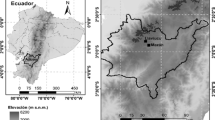Abstract
The results of the hearth and house experiments show that different types of seeds of different cultivated plants char to different extents. Cereal grains show a lower resistance to high temperatures, whereas grape pips and pulses become completely carbonized at higher temperatures. These differences mainly depend upon the structure of the seeds (thickness of the seed coat) even if other factors (moisture content and weather), difficult to control and measure, are also involved. The experiments provide valuable information for the interpretation of archaeobotanical material found in a reconstructed protohistoric house. By comparing the laboratory results and those obtained in the field, it was possible to get much information about the carbonization process of archaeobotanical material.














Similar content being viewed by others
References
Boardman S, Jones J (1990) Experiment on the effects on charring on cereal plant components. J Arch Sci 17:1–11
Castelletti L (1976) Rapporto preliminare sui resti vegetali macroscopici della serie neoliticobronzo di Pienza (Siena). Rivista Archeologica dell’antica provincia e diocesi di Como, Fasc, 156–7:243–251
Costantini L (1979) Plant remains at Pirak. In: Jarrige JF, Santoni M (eds) Fouilles de Pirak, vol. 1, Boccard Paris, pp 326–333
Costantini L (1989) Plant exploitation at Grotta dell’Uzzo, Sicily: new evidence for the transition from Mesolithic to Neolithic subsistence in southern Europe. In: Harris DR, Hillman GC (eds) Foraging and farming: the evolution of the plant exploitation, Unwin & Hyman, London, pp 197–206
Costantini L, Costantini-Biasini L, Lentini A (1997) Agricoltura e note sull’ambiente dell’abitato neolitico di Scamuso. In: Biancofiore F, Coppola D (eds) Scamuso Dipartimento di Storia dell’Università di Roma, Rome, pp 199–209
Costantini L, Stancanelli M (1994) La Preistoria agricola dell’Italia centro-meridionale: Il contributo delle Indogeni Archeobotaniche. Origini, Preistoria e Protohistoria delle Civiltà antiche 17:321–324
Cutler HC, Blake LW (1976) Plants from archaeological sites east of the Rockies. Am Arch Rep no 1. University of Missouri-Columbia
Gustafsson S (2000) Carbonized cereal grains and weed seeds in prehistoric houses, an experimental perspective. J Arch Sci 27:65–70
Hather J (1993) An archaeobotanical guide to root and tuber identification, vol 1. Europe and South West Asia. Oxbow Monograph 28, Oxford
Hopf M (1955) Formveranderungen von Getreide-Körner beim Verkohlen. Berichte der Deutschen Botanischen Gesellschaft, 68:191–193
Hopf M (1967) Analyse des céréales du niveau III (Chasséen). In: Galan A (ed) La station néolithique de la Perte du Cros à Saillac (Lot). Gallia Préhistorica 10:70–73
Pearsall DM (1980a) Analysis of an archaeological maize kernel cache from Manabi Province, Ecuador, Econ Bot 34:344–351
Renfrew J (1973) Palaeoethnobotany: the prehistoric food plants in the Near East and Europe. Columbia University Press, New York
Stewart RB, Robertson III W (1971) Moisture and seed carbonization. Econ Bot 25:381
Wilson DG (1984) The carbonization of weed seeds and their representation in macrofossil assemblages. In: Zeist W van, Casparie WA (eds) Plants and ancient man: studies in palaeoethnobotany. Balkema, Rotterdam, pp 39–43
Zohary D, Hopf M (2000) Domestication of plants in the Old World (3rd edn). Oxford University Press, Oxford
Acknowledgements
We thank G. Falcone for graphic support.
Author information
Authors and Affiliations
Corresponding author
Rights and permissions
About this article
Cite this article
Guarino, C., Sciarrillo, R. Carbonized seeds in a protohistoric house: results of hearth and house experiments. Veget Hist Archaeobot 13, 65–70 (2004). https://doi.org/10.1007/s00334-003-0026-3
Received:
Accepted:
Published:
Issue Date:
DOI: https://doi.org/10.1007/s00334-003-0026-3




